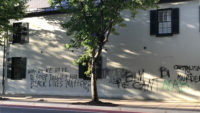AIA Issues Statement on Racial Injustice

The 2020 AIA Board of Directors. Image courtesy AIA.
The following is a statement from the American Institute of Architects, released June 4, 2020, on racial injustice.
To our members,
America's list of racially motivated murders demand action. Eric Garner. Sandra Bland. Michael Brown. Shantel Davis. Atatiana Jefferson. Laquan McDonald. Tony McDade. Pamela Turner. Korryn Gaines. Trayvon Martin. Tamir Rice. Walter Scott. Breonna Taylor, Ahmaud Arbery, and George Floyd. All murdered, because they happened to be black in the United States of America. There are others, and, sadly, we know there will be more. No words can adequately express the depth of anger, frustration, and national shame for their loss or the more than 1,250 black lives ended by police since January 1, 2015, according to The Washington Post's database that tracks police shootings.
Each of these lives should be a clarion call to action. They should spur all of us to do more, and that starts by speaking up, clearly, directly, and consistently.
To be clear, The American Institute of Architects supports the protests to stop systemic, state-sanctioned violence against people of color. Period. We support and are committed to efforts to ensure that our profession is part of the solution that finally dismantles systemic racial injustice and violence—the legacy of one of the United States' original sins, slavery.
The fact is mere words are insufficient salve to bind the wounds created by centuries of brutality and injustice. No single statement can adequately address the United States of America's 400-year legacy of enslavement and violent marginalization of black, indigenous, and other people of color. It is also a fact that what you say is what you do. In that regard, AIA's words and actions have failed to live up to our highest ideals and values. AIA understands the disappointment of our past inaction and inadequate attention to the issue of systemic racial injustice. We were wrong not to address and work to correct the built world's role in perpetuating systemic racial injustice, including the use of slave and forced labor, designing housing that marginalized communities of color, helping to design communities that excluded people of color, and participating in municipal projects that destroyed or weakened thriving African American, Hispanic, and Native American communities.
More than half a century has passed since Dr. Whitney M. Young, Jr., observed that "Decent people have to learn to speak up, and you shouldn't have to be the victim to feel for other people." We can't change the past, but we can, and do, promise to harness the passion of our members and the broader design community to help lead efforts to dismantle the system of racial injustice that continues to end far too many lives and dim far too many futures.
AIA's promise from this day forward is to hold close the anger, anguish, but above all, compassion we've heard from our members demanding that AIA speak out more clearly and urgently on racially motivated acts of violence and police brutality.
That important works starts with each of us. It is our responsibility to work together to break down the barriers that start in architecture school and continue into the firm and workplace that exclude far too many.
To that end, in the coming days and weeks, the focus of our actions will be to acknowledge, listen, and learn. We will review our own programs to directly confront and address systemic racial injustice. We will work more closely with partner organizations that can assist in making meaningful, lasting change for society and our profession. We will listen to our members and seek ways to remove barriers within the profession and AIA. For the longer term, we will ensure that the profession more closely reflects the diversity of society. In short, we are committed to lead in the fight to dismantle this country's centuries-old system of racial injustice and violence, so that future generations know the United States as a place where there is justice and equality for all.
We ask our community to join us and hold us accountable in the coming months and years to ensure that our deeds match our words. Our goal is to finally live up to Mr. Young's words "to speak up" and to learn so that the talent and the expertise of the architect and the built world only work to advance justice, equity and opportunity.
Eric Garner. Sandra Bland. Michael Brown. Shantel Davis. Atatiana Jefferson. Laquan McDonald. Tony McDade. Pamela Turner. Korryn Gaines. Trayvon Martin. Tamir Rice. Walter Scott. Breonna Taylor, Ahmaud Arbery, and George Floyd, the more than 1,250 souls lost to police brutality, and the thousands throughout our history who were killed and injured because of racial animus, deserve nothing less than our best efforts.



